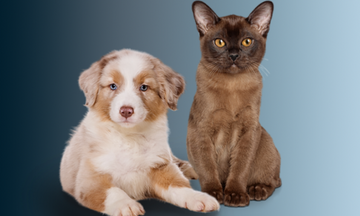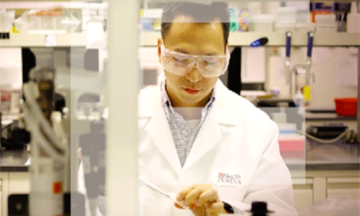微生物组基础知识

遗传学在微生物组的组成中起着重要作用。1尽管断奶后进行地理分隔,但有亲缘关系的犬的肠道微生物组的相似度高于无亲缘关系的犬。2
肠道的微生物定植首先受到母体微生物组、环境和营养的影响。
与出生时的组成相比,7 周龄幼犬的微生物组与母犬的微生物组更为相似。2幼犬的肠道微生物组的微生物多样性和种类丰富度在出生后 2 至 56 天间增加,但在出生后 42 天前相对稳定。3相比之下,幼猫的微生物组多样性在 4 周龄到 8 周龄间可能下降。4
一项宏基因组研究表明,幼猫的微生物组在 8 至 16 周龄间几乎没有变化,5另一项研究发现,结构和功能多样性在 18 至 30 周龄间发生变化,但在 30 至 42 周龄间无显著变化。6

随着年龄、疾病、医疗和其他应激源的增加,肠道中细菌的平衡会向较大的潜在致病菌种群转移。3、7、8
宠物的生活环境也会对肠道微生物组产生巨大影响。家养犬的微生物组与收容所收留犬的微生物组不同,收容所收留犬的微生物组群更具多样性。1较大城市留居犬的微生物组比在较小城市或农村地区留居犬的微生物组更具多样性。2
许多疾病状态与肠道微生物组菌群失调有关,但尚未明确确定菌群失调是病因还是疾病状态所导致的后果。1
发现患有慢性肠病、慢性腹泻和急性腹泻的犬均存在菌群失调。9、10
药物可能会影响微生物组。
特别是抗菌药物(例如,甲硝唑和泰洛林)可显著改变微生物组。1、11、12质子泵抑制剂(如,奥美拉唑)也对微生物组产生负面影响。1、13
肥胖与微生物组的变化有关,但尚不清楚微生物组的作用(是肥胖原因还是后果)。14、15
肥胖犬的微生物组对饮食的反应不同,其反应不如瘦犬的微生物组具有适应能力。15、16
肠道微生物群的组成主要受饮食影响。
微生物组可能受到成分特性、营养浓度和消化以及饮食制作程序的影响。17-24大量营养素成分似乎是推动微生物组组成发生变化的最重要饮食因素。17、24-29高蛋白饮食可增加蛋白水解微生物的丰度,而高碳水化合物饮食可增加糖溶性微生物的丰度。23
肠道微生物组在饮食改变后迅速变化,17、30、31这表明其组成具有很大的灵活性。然而,这些变化是可逆的,当犬恢复其原来饮食时,微生物组将恢复其原始组成。30、31
探索Microbiome Forum的其他部分
了解更多信息
- Belas, A., Marques, C., & Pomba, C. (2020).The gut microbiome and antimicrobial resistance in companion animals.In Duarte, A. & Lopes da Costa, L. (Eds.), Advances in Animal Health, Medicine and Production (1st ed.), pp. 233–245.Springer International Publishing
- Vilson, Å., Ramadan, Z., Li, Q., Hedhammar, Å., Reynolds, A., Spears, J.,…Hansson-Hamlin, H. (2018). Disentangling factors that shape the gut microbiota in German Shepherd dogs.PLoS ONE, 13(3), e0193507. doi:1371/journal.pone.0193507
- Guard, B. C., Mila, H., Steiner, J. M., Mariani, C., Suchodolski, J. S., & Chastant-Maillard, S. (2017). Characterization of the fecal microbiome during neonatal and early pediatric development in puppies. PLoS ONE, 12(4), e0175718. doi:10.1371/journal.pone.0175718
- Jia, J., Frantz, N., Khoo, C., Gibson, G. R., Rastall, R. A., & McCartney, A. L. (2011). Investigation of the faecal microbiota of kittens: monitoring bacterial succession and effect of diet. FEMS Microbiology Ecology, 78, 395–404. doi:10.1111/j.1574-6941.2011.01172.x
- Deusch, O., O’Flynn, C., Colyer, A., Morris, P., Allaway, D., Jones, P. G., & Swanson, K. S. (2014).Deep Illumina-based shotgun sequencing reveals dietary effects on the structure and function of the fecal microbiome of growing kittens. PLoS ONE, 9(7), e101021. doi:10.1371/ journal.pone.0101021
- Deusch, O., O’Flynn, Colyer, A., Swanson, K. S., Allaway, D., & Morris, P (2015). A longitudinal study of the feline faecal microbiome identifies changes in to early adulthood irrespective of sexual development. PLoS ONE, 10(12), e0144881. doi: 10.1371/journal.pone.0144881
- Romano-Keeler, J., & Weitkamp, J. H. (2015). Maternal influences on fetal microbial colonization and immune development. Pediatric Research, 77(1–2), 189–95. doi:10.1038/pr.2014.163
- Young, W., Moon, C. D., Thomas, D. G., Cave, N. J., & Bermingham, E. N. (2016). Pre- and post-weaning diet alters the faecal metagenome in the cat with differences vitamin and carbohydrate metabolism gene abundances. Scientific Reports, 6, 34668. doi:10.1038/srep34668
- Honneffer, J. B., Minamoto, Y., & Suchodolski, J. S. (2014). Microbiota alterations in acute and chronic gastrointestinal inflammation of cats and dogs. World Journal of Gastroenterology, 20(44), 16489–16497. doi:10.3748/wjg.v20.i44.16489
- Suchodolski, J. S., Markel, M. E., Garcia-Mazcorro, J. F., Unterer, S., Heilmann, R. M., Dowd, S. E.,…Toresson, L. (2012). The fecal microbiome in dogs with acute diarrhea and idiopathic inflammatory bowel disease. PLoS ONE, 7(12), e51907. doi:10.1371/journal.pone.0051907
- Igarashi, H., Maeda, S., Ohno, K., Horigome, A., Odamaki, T., & Tsujimoto, H. (2014). Effect of oral administration of metronidazole or prednisolone on fecal microbiota in dogs. PLoS ONE, 9(9), e107909. doi:10.1371/journal.pone.0107909
- Suchodolski, J. S., Dowd, S. E., Westermarck, E., Steiner, J. M., Wolcott, R. D., Spillmann, T., & Harmoinen, J. A. (2009). The effect of the macrolide antibiotic tylosin on microbial diversity in the canine small intestine as demonstrated by massive parallel 16S rRNA gene sequencing. BMC Microbiology, 9, 210. doi:10.1186/1471-2180/9/201
- Garcia-Mazcorro, J. F., Suchodolski, J. S., Jones, J. R., Clark-Price, S. C., Dowd, S. E., Minamoto, Y.,…Dossin, O. (2012). Effect of the proton pump inhibitor omeprazole on the gastrointestinal bacterial microbiota of healthy dogs. FEMS Microbiology Ecology, 80, 624-636.
- Handl, S., German, A. J., Holden, S. L., Dowd, S. E., Steiner, J. M., Heilman, R. M.,…Suchodolski, J. S. (2013). Faecal microbiota in lean and obese dogs. FEMS Microbiology Ecology, 84, 332343. doi: 10.1111/1574-6941.12067
- Li, Q., Lauber, C. L., Czarnecki-Maulden, G., Pan, Y., & Hannah, S. S. (2017). Effects of the Dietary Protein and Carbohydrate Ratio on Gut Microbiomes in Dogs of Different Body Conditions. MBio, 8(1), e01703–16. doi:10.1128/mBio.01703-16.
- Xu, J., Verbrugghe, A., Lourenco, M., Cools, A., Lui, D. J. X., Van de Wiele, T.,…Hesta, M. (2017). The response of canine faecal microbiota to increased dietary protein is influenced by body condition. BMC Veterinary Research, 13, 374. doi:10.1186/s12917-017-1276-0
- Do, S., Phungviwatnikul, T., de Godoy, M. R. C., & Swanson, K. S. (2021). Nutrient digestibility and fecal characteristics, microbiota, and metabolites in dogs fed human-grade foods. Journal of Animal Science, Epub ahead of print. doi:10.1093/jas/skab028/6123189
- Bermingham, E. N., Young, W., Kittelman, S., Kerr, K. R., Swanson, K. S., Roy, N. C., & Thomas, D. G. (2013). Dietary format alters fecal bacterial populations in the domestic cat (Felis catus). Microbiology Open, 2(1), 173–181. doi:10.1002/mbo3.60
- Kim, J., An, J.-U., Kim, W., Lee, S., & Cho, S. (2017). Differences in the gut microbiota of dogs (Canis lupus familiaris) fed a natural diet or a commercial feed revealed by the Illumina MiSeq platform. Gut Pathogens, 9, 68. doi:10.1186/s13099-017-0218-5
- Sandri, M., Dal Monego, S., Conte, G., Sgorlon, S., & Stefanon, B. (2017). Raw meat based diet influences faecal microbiome and end products of fermentation in healthy dogs. BMC Veterinary Research, 13, 65. doi:10.1186/s12917-017-0981-z
- Algya, K. M., Cross, T.-W. L., Leuck, K. N., Kastner, M. E., Baba, T., Lye, L., de Godoy, M. R. C., & Swanson, K. S. (2018). Apparent total-tract macronutrient digestibility, serum chemistry, urinalysis, and fecal characteristics, metabolites and microbiota of adult dogs fed extruded, mildly cooked, and raw diets. Journal of Animal Science, 96, 3670-3683. doi:10.1093/jas/sky235
- Hill, S. R., Rutherfurd-Markwick, K. J., Ravindran, G., & Thomas, D. G. (2015). The effects of differing proportions of dietary macronutrients on the digestibility and post-prandial endocrine responses in domestic cats (Felis catus). Journal of Applied Animal Nutrition, 3, e4. doi:10.1017/ jan.2015.2
- Schmidt, M., Unterer, S., Suchodolski, J. S., Honneffer, J. B, Guard, B. C., Lidbury, J. A.,…Kölle, P. (2018). The fecal microbiome and metabolome differs between dogs fed Bones and Raw Food (BARF) diets and dogs fed commercial diets. PLoS ONE, 13(8), e0201279. doi:10.1371/journal.pone.0201279
- Pilla, R., & Suchodolski, J. S. (2021).The gut microbiome of dogs and cats, and the influence of diet. Veterinary Clinics of North America Small Animal Practice, 51(3), 605-621. doi:10.1016/j.cvsm.2021.01.002
- Vester, B. M., Dalsing, B. L., Middlebos, I. S., Apanavicius, C. J., Lubbs, D. C., & Swanson, K. S. (2009). Faecal microbial populations of growing kittens fed high- or moderate-protein diets. Archives of Animal Nutrition, 63(3), 254–265.
- Hooda, S., Vester Boler, B. M., Dowd, S. E., Swanson, K. S. (2012). The gut microbiome of kittens is affected by dietary protein:carbohydrate ratio and correlated with blood metabolite and hormone concentrations. British Journal of Nutrition, 109, 1637–1646. doi:10.1017/S0007114512003479
- Bermingham, E. N., Kittelman, S., Young, W., Kerr, K. R.. Swanson, K. S., Roy, N. C., & Thomas, D. G. (2013). Post-weaning diet affects faecal microbial composition but not selected adipose gene expression in the cat (Felis catus). PLoS ONE, 8(11), e80992. doi:10.1371/ journal.pone.0080992
- Bermingham, E. N., Maclean, P., Thomas, D. G., Cave, N. J., & Young, W. (2017). Key bacterial families (Clostridiaceae, Erysipelotrichaceae and Bacteroidaceae) are related to the digestion of protein and energy in dogs. PeerJ, 5, e3019. doi:10.7717/peerj.3019
- Mori, A., Goto, A., Kibe, R., Oda, H., Kataoka, Y., & Sako, T. (2019). Comparison of the effects of four commercially available prescription diet regimens on the fecal microbiome in healthy dogs. Journal of Veterinary Medical Science, 81(12), 1783–1790. doi:10.1292/jvms.19-0055
- Herstad, K. M. V., Gajardo, K., Bakke, A. M., Moe, L., Ludvigsen, J., Rudi, K.,…Skancke, E. (2017). A diet change from dry food to beef induces reversible changes on the faecal microbiota in healthy, adult client-owned dogs. BMC Veterinary Research, 13, 147. doi:10.1186/s12917-017-1073-9
- Allaway, D., Haydock, R., Lonsdale, Z. N,, Deusch, O. D., O’Flynn, C., & Hughes, K. R. (2020). Rapid reconstitution of the faecal microbiome after extended diet-induced changes indicate a stable gut microbiome in healthy adult dogs. Applied Environmental Microbiology, Epub ahead of print. doi:10.1128/AEM.00562-20


